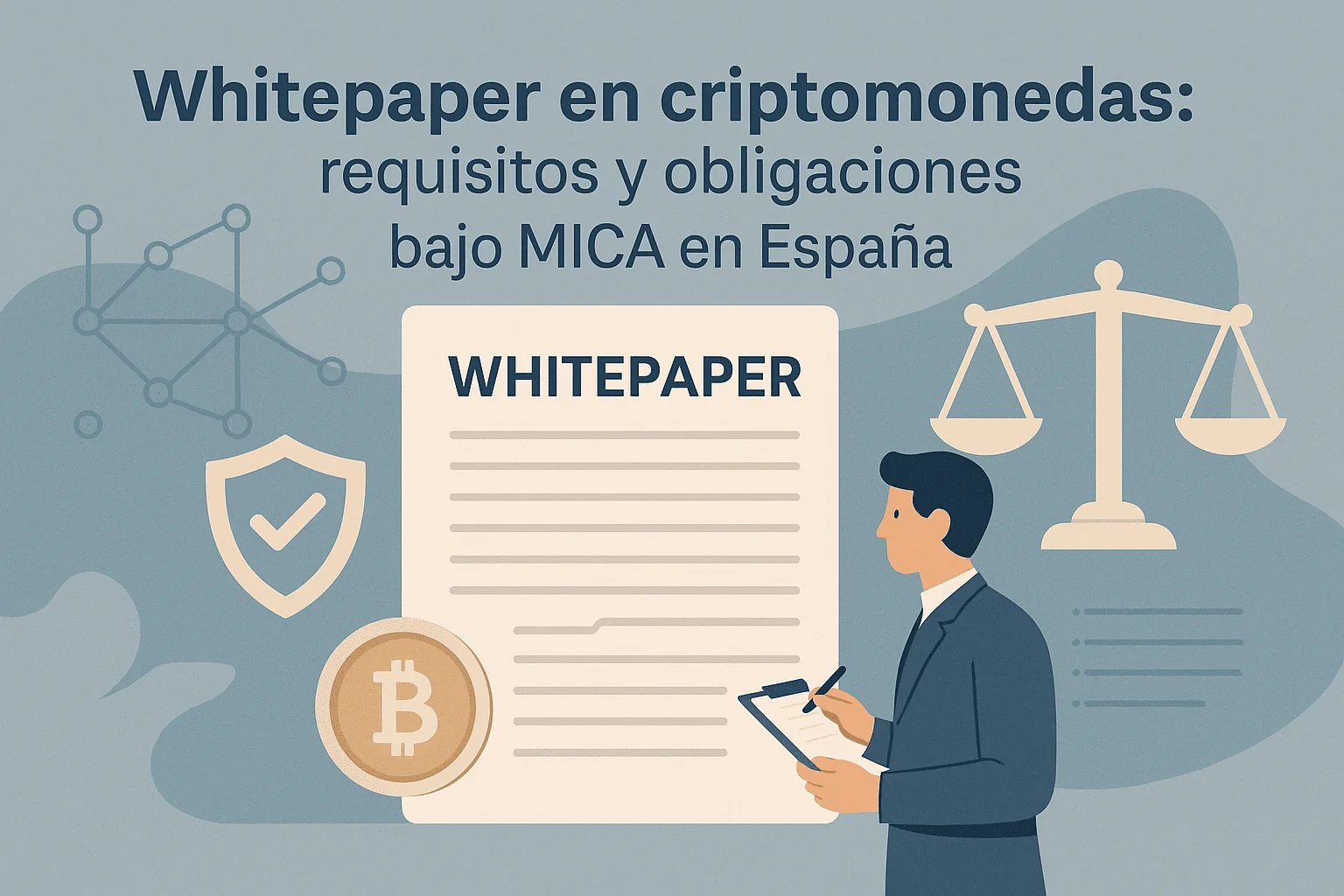Investment Funds in Crypto-Assets in Spain: Limits, Regulation, and Viability
Is it possible to create a cryptocurrency investment fund in Spain? We analyze the regulatory framework, current limits, and the options available in 2025.
Read more →
The MICA Regulation has brought a key transformation to the European crypto ecosystem: the obligation to publish a whitepaper — also known as a libro blanco — for public offerings of cryptocurrencies. This practice, which until now was common but voluntary, becomes a legal requirement under certain conditions, especially for issuers operating in Spain or within the European Union market.
In this article, we analyze when a whitepaper is mandatory, what it must include, how it is notified, which rules govern advertising, and what rights consumers have.
Traditionally, the whitepaper has been the informal document that crypto projects used to explain their value proposition. However, the MICA Regulation turns it into a mandatory instrument for cryptocurrency issuers (except in specific cases), establishing requirements regarding content, format, and advertising.
MICA refers to it as a libro blanco, but in legal and technical practice, it is the mandatory whitepaper required to launch a cryptocurrency lawfully.
All legal entities that carry out a public offering of cryptocurrencies (other than stablecoins or e-money tokens), except in the following cases:
- The offer is completely free, without consideration or exchange of data.
- Tokens are generated exclusively through mining or staking.
- The offer is aimed at fewer than 150 professional investors and does not exceed 1 million euros within one year.
In addition, public offerings of utility tokens may only be carried out within a maximum period of 12 months.
The MICA Regulation requires that every whitepaper must include at least:
- Information about the issuer and the main persons responsible for the project.
- A clear description of the project and the type of cryptocurrency offered.
- Reasons for the public offering or admission to trading.
- Intended use of the funds raised.
- Number of tokens, issue price, and subscription terms.
- Rights associated with the crypto-assets and how to exercise them.
- Underlying technology, maintenance, and applied standards.
- Risk assessment of the issuer, the token, the project, and the offering.
- The elements set out in Annex I of the MICA Regulation.
Additionally:
- The language must be clear, non-deceptive, and not misleading.
- It must include a notice stating that it has not been approved by competent authorities.
- It must warn of risks such as total loss, illiquidity, or non-convertibility.
- It must include a jargon-free summary and be presented in an electronically readable format.
- ESMA may issue templates and models to standardize its format across the EU.
In Spain, if the project is neither a stablecoin nor a token linked to electronic money, the issuer must:
- Notify the whitepaper to the competent authority (CNMV).
- Do so at least 20 business days before publication.
- Indicate the countries where the crypto-assets will be distributed and the start date.
- Include justification excluding its nature as a financial instrument.
This notification must also include the planned advertising communications.
Advertising of cryptocurrency offerings — now regulated by Article 6 of MICA — must adhere to principles of truthfulness and consistency with the whitepaper.
The regulation requires that:
- Communications must be clearly identifiable as advertising.
- They must be clear, impartial, and not misleading.
- The content must match the whitepaper.
- The existence of the whitepaper must be explicitly mentioned, and the issuer’s website indicated.
- The whitepaper must remain publicly accessible while the tokens are in circulation.
Any subsequent modification to the whitepaper must:
- Be duly justified and explained.
- Be publicly communicated along with the reasons for the change.
- Be submitted again to the CNMV at least 7 business days before the new publication.
- Be reflected in advertising communications if applicable.
- Include the date of the change and remain accessible while the offering or circulation lasts.
MICA introduces a significant consumer protection right: the right of withdrawal. Article 12 states that the buyer has 14 calendar days to cancel their cryptocurrency purchase without reason or cost.
Issuer obligations:
- Refund the full amount paid, including any fees.
- Do so without undue delay and no later than 14 days after the request.
- Use the same payment method, unless expressly authorized otherwise by the client.
When does this right not apply?
- If the tokens have already been admitted to trading on a platform.
- Or if the subscription period of the offering has ended.
The cryptocurrency whitepaper evolves from being an informal marketing tool to becoming a central legal requirement under MICA. Its purpose is not only to formalize offerings but also to ensure transparency, reduce fraud, and protect consumers.
Although it imposes more obligations on issuers, it also fosters trust, professionalizes the sector, and provides a predictable framework for investment. Ultimately, it is another step toward a stronger, more transparent, and more attractive European crypto market.